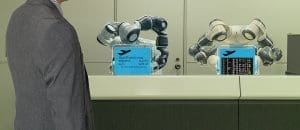 Self-service technologies (SSTs) have simplified many aspects of everyday life. However, their relatively recent introduction means that the pros and cons of SST adoption in the hotel industry are still being explored. The potential advantages of SSTs notwithstanding, hotels in China seem to have some reservations, say Professor Kam Hung of the School of Hotel and Tourism Management (SHTM) at The Hong Kong Polytechnic University and her co-researcher. Without a clear understanding of how preferences for SSTs over human staff are formed, hoteliers are perhaps right to be wary. Moving beyond previous work, this ambitious study integrates individual-level and organisational-level data on the construction of SST preferences. The researchers’ comprehensive findings offer a starting point for hoteliers wishing to effectively introduce SSTs.
Self-service technologies (SSTs) have simplified many aspects of everyday life. However, their relatively recent introduction means that the pros and cons of SST adoption in the hotel industry are still being explored. The potential advantages of SSTs notwithstanding, hotels in China seem to have some reservations, say Professor Kam Hung of the School of Hotel and Tourism Management (SHTM) at The Hong Kong Polytechnic University and her co-researcher. Without a clear understanding of how preferences for SSTs over human staff are formed, hoteliers are perhaps right to be wary. Moving beyond previous work, this ambitious study integrates individual-level and organisational-level data on the construction of SST preferences. The researchers’ comprehensive findings offer a starting point for hoteliers wishing to effectively introduce SSTs.
SSTs allow customers to enjoy services completely free of interaction with service providers. They are “high-tech and ‘low-touch’ interfaces”, explain the researchers, “in contrast with traditional interpersonal encounters, which are generally high-touch and low-tech”. Self-check-in systems, robots, smart speakers and self-ordering gadgets are becoming increasingly common in hotels. Some are even testing AI-based SSTs such as facial recognition check-in kiosks. In China (and beyond), the pandemic has undoubtedly also accelerated hotels’ SST adoption in attempts to limit customer–employee contact. “As of October 2020, more than 3000 hotels in China were equipped with robots from Yunji Technology, a service robot provider”, report the authors.
SST interfaces allow hoteliers to provide services in the physical absence of service employees, with the clear benefits of reducing operating costs and increasing profits. Whilst some have predicted a continuing boom in these technological trends, SST adoption in hotels has remained surprisingly low, perhaps because it all but eliminates customer–employee interaction. “As a people-oriented service industry, hotels face difficult decisions regarding whether to introduce SSTs,” say the researchers. For hotels to make more informed decisions, it is crucial to discover what influences SST preferences. This new knowledge could in turn help ease the technological transition to SSTs for both hoteliers and guests.
Most research on SST adoption has focused on the individual-level factors that underpin technology acceptance, such as a person’s thoughts, feelings and behaviours. However, this completely overlooks the possible consequences of external or managerial actions. “Most technology adoption situations involve phenomena at multiple levels, including individuals, organisations, industries, and societies”, stress the authors. Yet theories based on individual-level data have often been applied to organisational contexts. To tackle this problem, the researchers built a hierarchical framework to better reflect the multi-level situation of SST adoption and bridge the micro–macro divide.
The researchers conducted in-depth qualitative interviews with 30 hoteliers who had implemented innovative SSTs in their hotels and 29 customers who had used hotel SSTs. The SSTs discussed included robots, check-in and check-out kiosks, mobile tablets, and smartphones. The majority of the 59 face-to-face interviews were conducted in Shenzhen, Hangzhou and Hong Kong. The interviews were audio-recorded and transcribed, allowing the researchers to conduct a thorough content analysis to identify and categorise major themes contained within the interviews.
The four major themes that influenced customers’ and hoteliers’ SST preferences were environmental factors, the organisational context, service task attributes, and customer experiences. Environmental factors included public familiarity with SSTs, government regulations, and concerns about environmental protection. The organisational context included the relationships between hotels, technology companies, and other hotel stakeholders. The theme of service task attributes reflected how customers co-produced services with the service channel, be that SSTs or service employees. Finally, customer experiences during service encounters included aesthetic, affective, cognitive, actional, and social experiences.
As an initial finding, the interviews revealed that for both hoteliers and guests, the preference for SSTs was swayed by the belief that SSTs are environmentally friendly. However, another environmental factor posed a problem for hoteliers. “The Chinese government mandates that hotels upload guests’ identifying information in real time”, the researchers explain, “making selfcheck-in impossible without government approval”. Both the hoteliers and the customers were sceptical about introducing technologies to the service industry. “Many commented that hotel service is a human-oriented business”, say the researchers. “The use of emotionless technologies may result in indifference”.
Within the theme of organisational context, both hoteliers and customers spoke of the economic benefits of SSTs for hotels, such as decreased workload and enhanced efficiency. They considered SSTs to be better suited to new, business-focused and non-luxury hotels with more rooms, especially in the case of check-in and check-out kiosks. “Moreover, SSTs were seen as conducive to brand marketing,” report the researchers. For example, both hoteliers and customers agreed that innovative SSTs such as robots can be a selling point to attract guests.
Concerning service task attributes, both hoteliers and customers criticised SSTs for their lack of customisation and personalisation. Both groups also noted instances in which SSTs fell short of human-delivered services, largely owing to the lack of any two-way communication. That said, both groups regarded SSTs as reliable, punctual, available 24/7, and less likely to make mistakes than service employees. “Hoteliers stated that SSTs do not need rest, cannot fall ill, and cannot resign; rather, they are always on call, enabling hotel guests to receive service at any time”, add the researchers.
Within the theme of customer experiences, the preferences of both hoteliers and customers were influenced by whether the SST experience was superior to that of human services. Customers’ preferences were also guided by the device’s appearance and voice, its usefulness, convenience, and cleanliness, as well as its ability to evoke pleasure, surprise, and relaxation. Respect, trust, safety, and privacy were also major contributors to SST preferences in both groups, although customers’ opinions on this were more divergent. “In some cases, they felt relieved and safer when tackling problems on their own rather than depending on service employees”, the researchers explain. “Others, however, worried about their personal safety or the privacy of their information”.
In pinpointing differences between customers and hoteliers, the researchers were able to provide critical observations that might be instrumental for efficient SST introduction. In some cases, hoteliers placed importance on factors not even mentioned by customers. Moreover, hoteliers paid more attention to environmental and organisational factors, such as incompatibility with existing features and technology company contributions. Guests tended to focus on customer differences and the importance of consistency far more than hoteliers did. Hoteliers wishing to deliver desirable consumer experiences should pay more attention to guests’ opinions, the authors conclude.
Armed with this formidable body of data, the researchers then developed a hierarchical framework that integrated both individual- and organisational-level variables to explain the development of SST preference. This framework reflected the interplay between the external environment, the organisational context, internal service encounters, and core customer experiences in the development of preferences for SSTs over human staff.
“The findings can help hotel practitioners make more rational SST adoption decisions”, conclude the authors, such as collaborating with technology companies, involving other hotel stakeholders in SST promotion, thoroughly testing SSTs before procuring them, and giving consideration to the time needed to introduce SSTs.
This innovative study could support the introduction and implementation of SSTs in the hospitality industry in China. Its findings call for hoteliers to promote SST features that are desirable and important to their guests. The novel framework presented by the authors provides a springboard for hotel managers to better market SST-infused hospitality services and promote customer acceptance. Certainly, if service management can successfully consider customers’ SST-based experiences, this will “contribute to organisational profitability and success in a competitive marketplace”, note the authors. Beyond that, the proposed hierarchical framework is the first attempt to explain the multi-level determinants of technology adoption, and could potentially be adapted to specific innovations and individual or organisational situations.
About the authors
Liu, Chun and Hung, Kam (2021). A Multilevel Study on Preferences for Self-service Technology versus Human Staff: Insights from Hotels in China. International Journal of Hospitality Management, Vol. 94, 102870.














